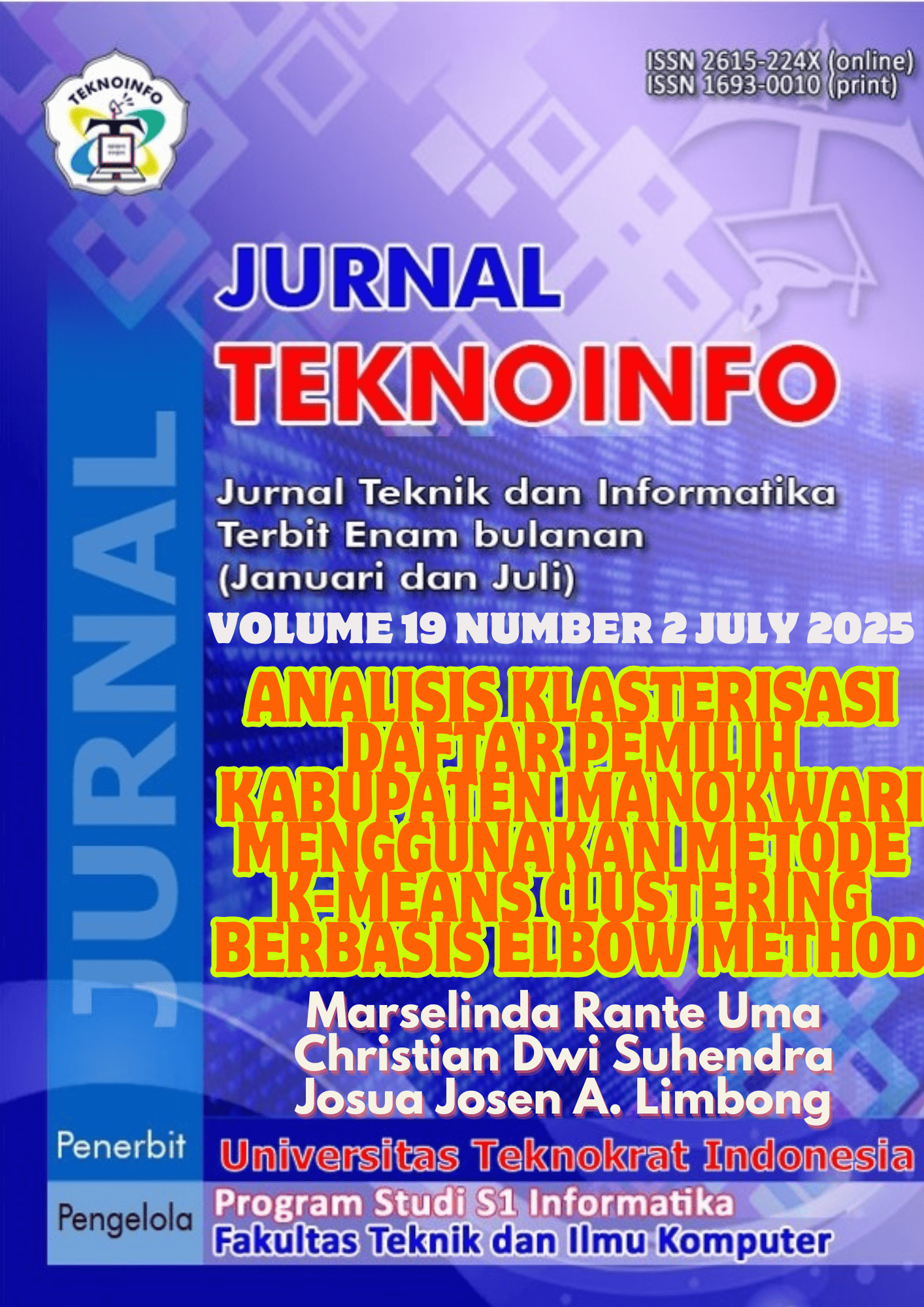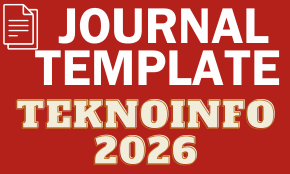ANALISIS KLASTERISASI DAFTAR PEMILIH KABUPATEN MANOKWARI MENGGUNAKAN METODE K-MEANS CLUSTERING BERBASIS ELBOW METHOD
Abstract
General Elections (Pemilu) are a crucial pillar in Indonesia's democratic system, ensuring public representation in government. As voter data becomes increasingly complex due to population growth and community mobility, electoral data management requires more efficient analytical approaches to support accurate decision-making. Therefore, methods capable of accurately grouping voters based on specific characteristics are needed. This study aims to cluster voter registration data in Manokwari Regency based on age and neighborhood unit (RT) using the K-Means algorithm. A total of 16,871 entries obtained from the General Election Commission of Manokwari Regency were used, but two outliers due to input errors were removed, leaving 16,869 valid entries analyzed using Jupyter Notebook. The Elbow Method was applied to determine the optimal number of clusters by calculating the Sum of Squared Errors (SSE) from K = 2 to K = 9. The most significant drop in SSE occurred from K = 2 to K = 3 and K = 3 to K = 4, with gradual decreases afterward, indicating the elbow point lies between K = 3 and K = 4. Considering data density and segmentation, K = 4 was chosen with an SSE value of 347,575. The K-Means algorithm then clustered the data based on age and RT through random centroid initialization, Euclidean distance calculation, reassignment, and iterative centroid updates until convergence. The results showed four clusters: Cluster_0 with 6,332 young voters aged 17–29 years (RT 0–17), Cluster_1 with 3,478 productive-age voters aged 43–56 years (RT 0–14), Cluster_2 with 1,768 elderly voters aged 57–93 years (RT 0–14), and Cluster_3 with 5,291 voters aged 30–42 years (RT 0–15). The broad RT distribution across clusters indicates diverse voter age groups across the region. These findings can help the Manokwari General Election Commission (KPU) and related institutions in planning effective voter education, outreach, and logistics distribution strategies.
References
M. I. Rantau, “Penguatan Sistem Presidensial Di Indonesia: Analisis Terhadap Undang Undang No 7 Tahun 2017 Tentang Pemilihan Umum,” J. Penelit. Dan Karya Ilm., vol. 19, no. 2, pp. 181–193, 2019, doi: 10.33592/pelita.vol19.iss2.120.
L. Nasution, “Pemilu dan Kedaulatan Rakyat,” ’Adalah, vol. 1, no. 9, pp. 83–84, 2017, doi: 10.15408/adalah.v1i9.11323.
D. Anggara, “Kajian Umum Pilkada,” Africa’s potential Ecol. Intensif. Agric., vol. 53, no. 9, pp. 1689–1699, 2019.
Y. Andrianus, W. Wasino, and T. Sutrisno, “Implementasi Algoritma K-Means Terhadap Opini Masyarakat Mengenai Perkiraan Pemilu 2024 Pada Twitter,” Simtek J. Sist. Inf. dan Tek. Komput., vol. 8, no. 2, pp. 305–308, 2023, doi: 10.51876/simtek.v8i2.271.
S. D. Hilda, A. Voutama, and Y. Umaidah, “Analisis Daftar Pemilih Tetap Pemilihan Gubernur dan Wakil Gubernur menggunakan Algoritma K-Means,” JATISI (Jurnal Tek. …, vol. 10, no. 3, pp. 398–408, 2023, [Online]. Available: https://jurnal.mdp.ac.id/index.php/jatisi/article/view/4921%0Ahttps://jurnal.mdp.ac.id/index.php/jatisi/article/download/4921/1600
R. Arviyanda, E. Fernandito, and P. Landung, “Analisis Perbedaan Bahasa dalam Komunikasi Antarmahasiswa,” J. Harmon. Nusa Bangsa, vol. 1, no. 1, p. 67, 2023, doi: 10.47256/jhnb.v1i1.338.
A. Winarta and W. J. Kurniawan, “Optimasi Cluster K-Means Menggunakan Metode Elbow Pada Data Pengguna Narkoba Dengan Pemrograman Python,” JTIK (Jurnal Tek. Inform. Kaputama), vol. 5, no. 1, pp. 113–119, 2021, doi: 10.59697/jtik.v5i1.593.
L. P. Refialy, H. Maitimu, and M. S. Pesulima, “Perbaikan Kinerja Clustering K-Means pada Data Ekonomi Nelayan dengan Perhitungan Sum of Square Error (SSE) dan Optimasi nilai K cluster,” Techno.Com, vol. 20, no. 2, pp. 321–329, 2021, doi: 10.33633/tc.v20i2.4572.
D. A. I. C. Dewi and D. A. K. Pramita, “Analisis Perbandingan Metode Elbow dan Silhouette pada Algoritma Clustering K-Medoids dalam Pengelompokan Produksi Kerajinan Bali,” Matrix J. Manaj. Teknol. dan Inform., vol. 9, no. 3, pp. 102–109, 2019, doi: 10.31940/matrix.v9i3.1662.
R. Nainggolan, R. Perangin-Angin, E. Simarmata, and A. F. Tarigan, “Improved the Performance of the K-Means Cluster Using the Sum of Squared Error (SSE) optimized by using the Elbow Method,” J. Phys. Conf. Ser., vol. 1361, no. 1, 2019, doi: 10.1088/1742-6596/1361/1/012015.
L. Azzahra and Amru Yasir, “Metode K-Means Clustering Dalam Pengelompokan Penjualan Produk Frozen Food,” J. Ilmu Komput. dan Sist. Inf., vol. 3, no. 1, pp. 1–10, 2024, doi: 10.70340/jirsi.v3i1.88.
A. Srirahayu and L. S. Pribadie, “Review Paper Data Mining Klasifikasi Data Mining,” J. Ilm. Inform. Glob., vol. 14, no. 1, 2023, doi: 10.36982/jiig.v14i1.2981.
R. Yuliani, B. Pusat, S. Provinsi, and K. Utara, “Identifikasi Nilai Esensial Dari Outlier Non-Extreme Menggunakan Metode Minimum Volume Ellipsoid,” AJurnal TEKINKOM, vol. 6, no. 1, pp. 236–244, 2023, doi: 10.37600/tekinkom.v6i1.572.

Copyright (c) 2025 Marselinda Rante Uma, Christian Dwi Suhendra, Josua Josen A. Limbong

This work is licensed under a Creative Commons Attribution-NonCommercial-ShareAlike 4.0 International License.





